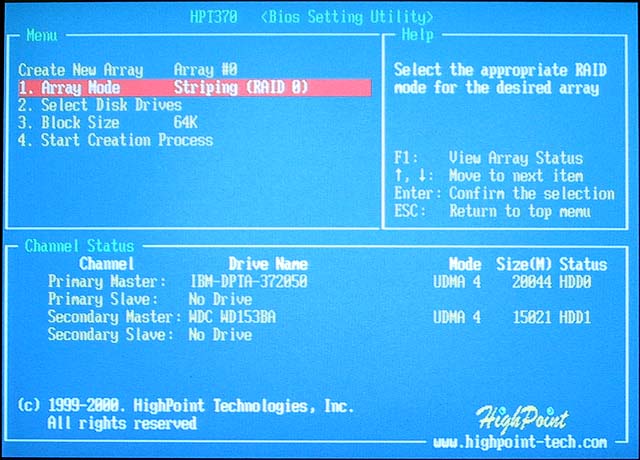ABIT KT7-RAID Socket-A KT133 ATX
by Anand Lal Shimpi on August 12, 2000 1:01 AM EST- Posted in
- Motherboards
Just as with the BX133-RAID, the KT7-RAID is the second ABIT board to substitute the HPT370 controller in place of HighPoint's older HPT366 controller. The HPT370 adds Ultra ATA/100 (the HPT366 was Ultra ATA/66 only) and, more importantly, RAID support in the same compact single chip package. Hard drive performance is by far one of the biggest bottle necks in today's systems, especially for typical everyday use such as most Internet and business applications. The HPT370 supports striping (RAID 0), mirroring (RAID 1), and mirroring + striping (RAID 0+1). By buying a motherboard with an integrated RAID controller, you save quite a bit over buying a motherboard and than a separate RAID controller. ABIT has included Windows 98, 2000, and NT 4.0 drivers on their CD, while the HighPoint driver built into the latest Linux kernels should work as well.

Is there a need for Ultra ATA/100 support? The main thing to realize is that no hard drive requires Ultra ATA/100 since no hard drive can consistently transfer at speeds greater than 66MB/s, the current fastest drive transfers at just under 40MB/s. Even when bursting the fastest IDE drives barely exceed Ultra ATA/66's 66MB/s limit, so for now, there is no need for Ultra ATA/100. However, if you do plan on keeping your system as is for a decent amount of time, the HighPoint controller may come in handy as there will be a point where Ultra ATA/66's 66MB/s transfer rate limit will become a bottleneck. And for those of you that don't care for the Ultra ATA/100 and RAID support, ABIT makes a base version of the KT7-RAID which just carries the KT7 name without the '-RAID' extension. The bare KT7 should also be a cheaper solution.
The
HPT366 has been known to have compatibility problems with certain devices, including
CD-ROM's and even some hard drives. It's not yet clear whether all of these
issues have been resolved with the HPT370, but your best bet is to search around
the net to see if anyone has had any troubles with their KT7-RAID's and the
particular devices you plan on having on the HPT370 channels (also check with
BX133-RAID owners since they have the same controller). We didn't encounter
any problems during our testing with the HPT370 controller, but we will keep
you posted if we do indeed discover anything that could be a potential issue.
One benefit of having this controller onboard is that you still have the two
Ultra ATA/66 channels courtesy of VIA's 686A South Bridge, which can be
used for all non-Ultra ATA 66/100 devices.
From an expansion perspective, ABIT did the KT7 perfectly for the hardware enthusiast. Since ABIT isn't big on the OEM side of motherboard sales, they don't necessarily have to worry about things like adding in on-board audio codecs and AMR slots. While the lack of major OEM contracts does hurt ABIT in terms of overall sales figures, it doesn't hurt their stature in the eyes of the very large group of hardware enthusiasts we have visiting AnandTech as well as other online sites.
As we just alluded to, and as you can probably tell by looking at the board itself, the KT7 doesn't feature an AMR slot, instead it has a very roomy 6/1/1 (PCI/ISA/AGP) expansion slot configuration. The single ISA slot seems to go over very well with those that have the lone ISA peripheral they just can't get rid of (modem, old SCSI card for an old tape drive, etc...) as well as those that don't have any ISA peripherals since it is shared with the 6th PCI slot, meaning that having it didn't prevent the placement of any more PCI slots. Since the VIA 686A South Bridge features an integrated PCI-ISA bridge the only added costs involved to place that ISA slot on the KT7-RAID were those associated with mounting the physical slot on the board.
The KT7-RAID boasts a hefty 1.5GB memory support limit provided by the KT133 chipset in combination with the three physical 168-pin SDRAM DIMM slots. While the chipset supports both regular SDRAM as well as Virtual Channel SDRAM operating at either 100 or 133MHz, we have yet to see a tangible performance increase courtesy of using VC-SDRAM. One advantage that the VIA chipsets currently have is that there is no Intel chipset that supports the 133MHz FSB/memory bus and more than 512MB SDRAM, the only thing would be Intel's BX chipset overclocked to the 133MHz FSB which can begin to have instability issues if the memory bus is loaded down as we discovered in our BX-133 Video Guide.
So for those that are looking to run a high-end workstation/server platform and need a powerful CPU as well as a fast memory bus, even Intel's new 815 may not be viable as it can "only" support 512MB of RAM, leaving the KX133/KT133 platforms as a very tempting choice; not a bad thing for VIA at all, especially considering their Apollo Pro 133A is the only Pentium III chipset that doesn't require expensive RDRAM and can support more than 512MB of RAM.










0 Comments
View All Comments